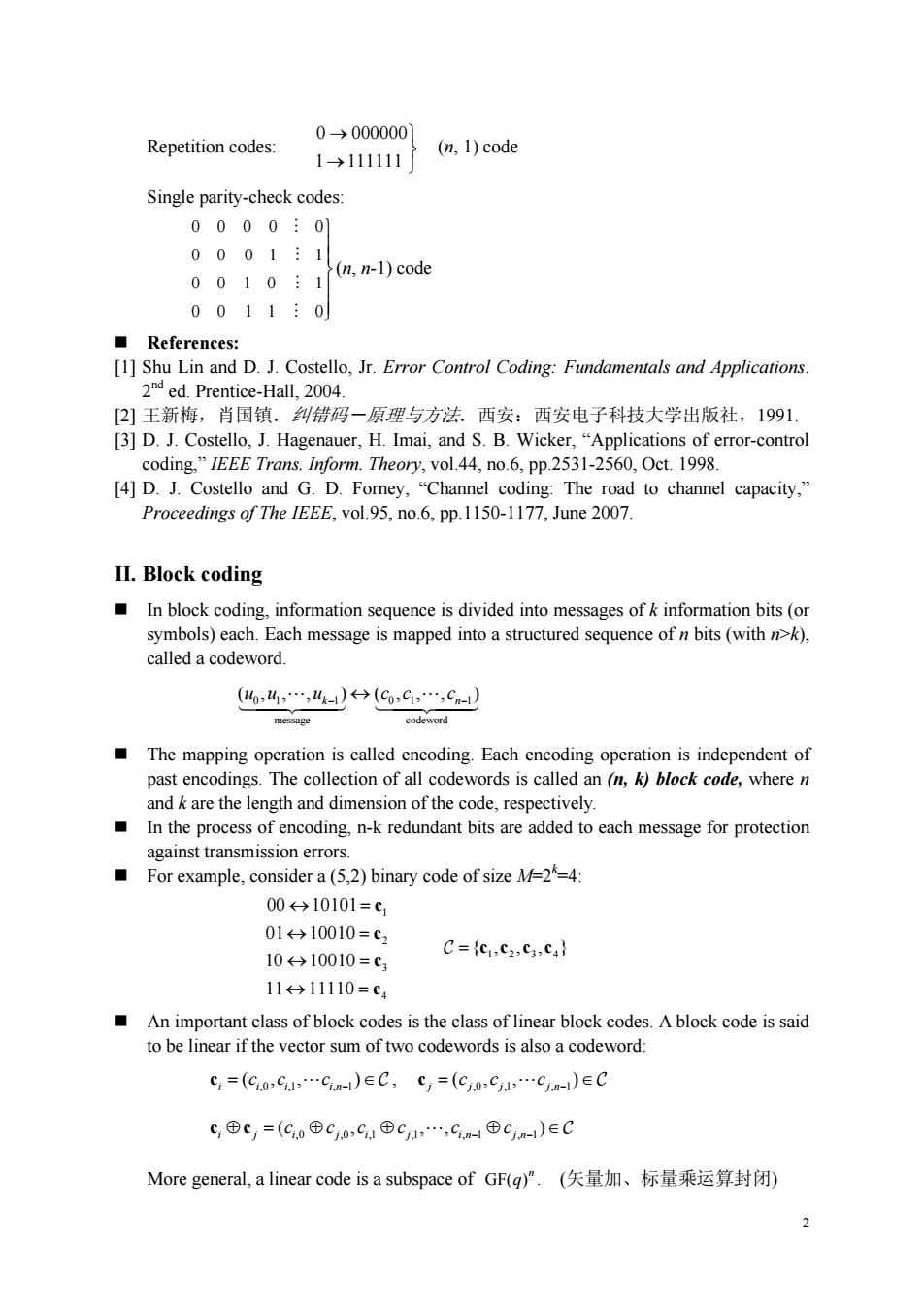正在加载图片...

0→0000001 Repetition codes: 1→111111 (n,1)code Single parity-check codes: 0000:01 0001:1 1(.1)code 0011:0 ■References: [1]Shu Lin and D.J.Costello,Jr.Error Control Coding:Fundamentals and Applications 2 ed Prentice-Hall 2004 [2]王新梅,肖国镇.纠错码一原理与方法.西安:西安电子科技大学出版社,1991 [3]D.J.Costello,J.Hagenauer.H.Imai,and S.B.Wicker,"Applications of error-control coding."IEEE Trans.Inform.Theory,vol44,no.6,pp.2531-2560,Oct.1998. [4]D.J.Costello and G.D.Forney,"Channel coding:The road to channel capacity," Proceedings of The IEEE,vol.95,no.6,pp.1150-1177,June 2007. II.Block coding In block coding,information sequence is divided into messages ofk information bits(or symbols)each.Each message is mapped into a structured sequence of n bits(with), ealled a codeword. (,4,.4-)(G0,9,.,cn-) codeweed The mapping operation is called encoding.Each encoding operation is independent of past encodings.The collection of all codewords is called an (n.k)block code,where n and k are the】 ength and dime sion of the code, resp In the process of encoding.n-k redundant bits are added to each message for protection against transmission errors For example,consider a(5,2)binary code of size M2=4 0010101=c 01←→10010=c 1010010=c3 C={c,c2,c3,c4} 11←→11110=c An important class of block codes is the class of linear block codes.A block code is said to be linear if the vector sum of two codewords is also a codeword: c,=(Co,C,.C-)eC, ,=(C.0,C.C-)eC C,⊕Cy=(Co⊕C0,C⊕C,.,Cn-®cn-i)eC More general,a linear code is a subspace of GF(g)”.(矢量加、标量乘运算封闭)2 Repetition codes: 0 000000 1 111111 → ⎫ ⎬ → ⎭ (n, 1) code Single parity-check codes: 0000 0 00 01 1 0010 1 0 0 11 0 ⎫ ⎪ ⎪ ⎬ ⎪ ⎪⎭ # # # # (n, n-1) code References: [1] Shu Lin and D. J. Costello, Jr. Error Control Coding: Fundamentals and Applications. 2nd ed. Prentice-Hall, 2004. [2] 王新梅,肖国镇.纠错码-原理与方法.西安:西安电子科技大学出版社,1991. [3] D. J. Costello, J. Hagenauer, H. Imai, and S. B. Wicker, “Applications of error-control coding,” IEEE Trans. Inform. Theory, vol.44, no.6, pp.2531-2560, Oct. 1998. [4] D. J. Costello and G. D. Forney, “Channel coding: The road to channel capacity,” Proceedings of The IEEE, vol.95, no.6, pp.1150-1177, June 2007. II. Block coding In block coding, information sequence is divided into messages of k information bits (or symbols) each. Each message is mapped into a structured sequence of n bits (with n>k), called a codeword. 01 1 01 1 message codeword (, , ) (, , ) k n uu u cc c " " − − ↔
The mapping operation is called encoding. Each encoding operation is independent of past encodings. The collection of all codewords is called an (n, k) block code, where n and k are the length and dimension of the code, respectively. In the process of encoding, n-k redundant bits are added to each message for protection against transmission errors. For example, consider a (5,2) binary code of size M=2k =4: 1 2 1234 3 4 00 10101 01 10010 {, , , } 10 10010 11 11110 ↔ = ↔ = = ↔ = ↔ = c c cccc c c C An important class of block codes is the class of linear block codes. A block code is said to be linear if the vector sum of two codewords is also a codeword: ,0 ,1 , 1 (, ) i i i in cc c = ∈ − c " C , ,0 ,1 , 1 (, ) j j j jn cc c c = " − ∈C ,0 ,0 ,1 ,1 , 1 , 1 ( , , ) i j i j i j in jn c cc c c c ⊕= ⊕ ⊕ ⊕ ∈ − − c c " C More general, a linear code is a subspace of GF( )n q . (矢量加、标量乘运算封闭)